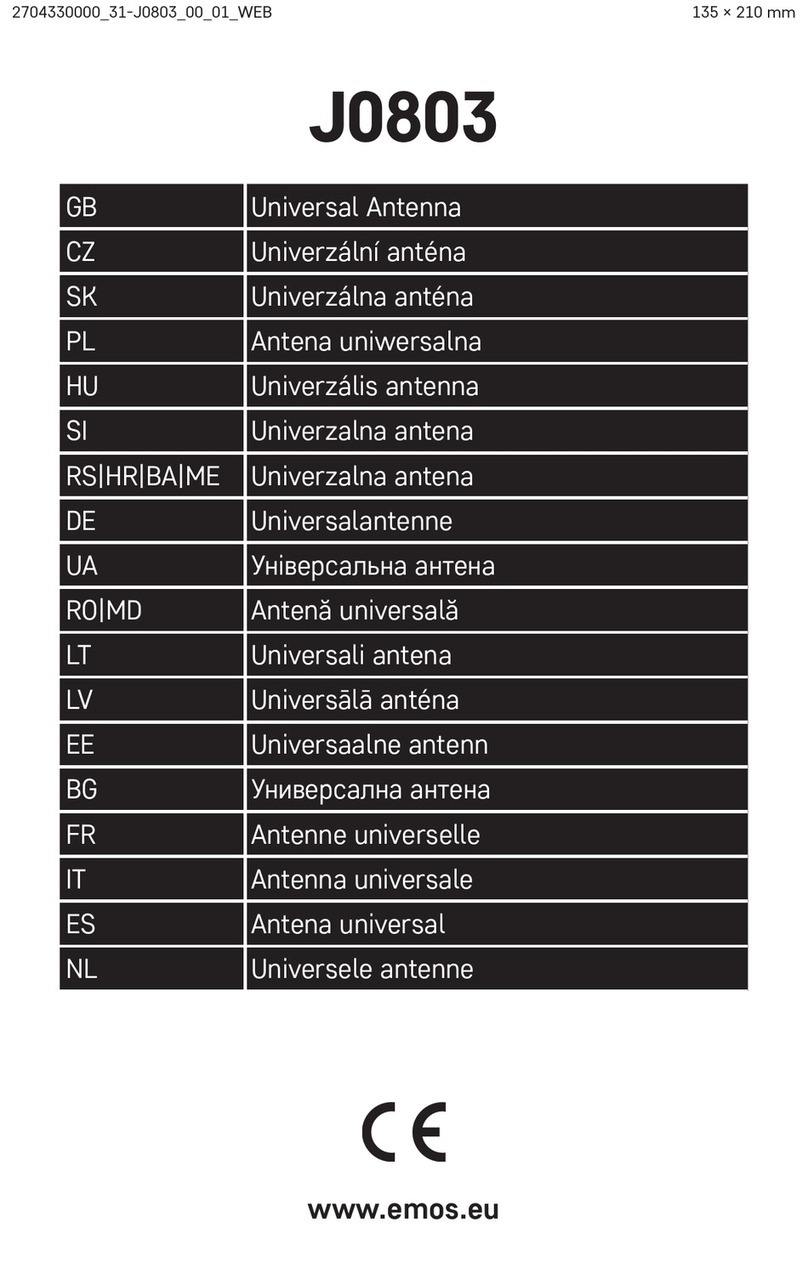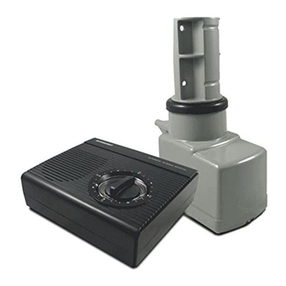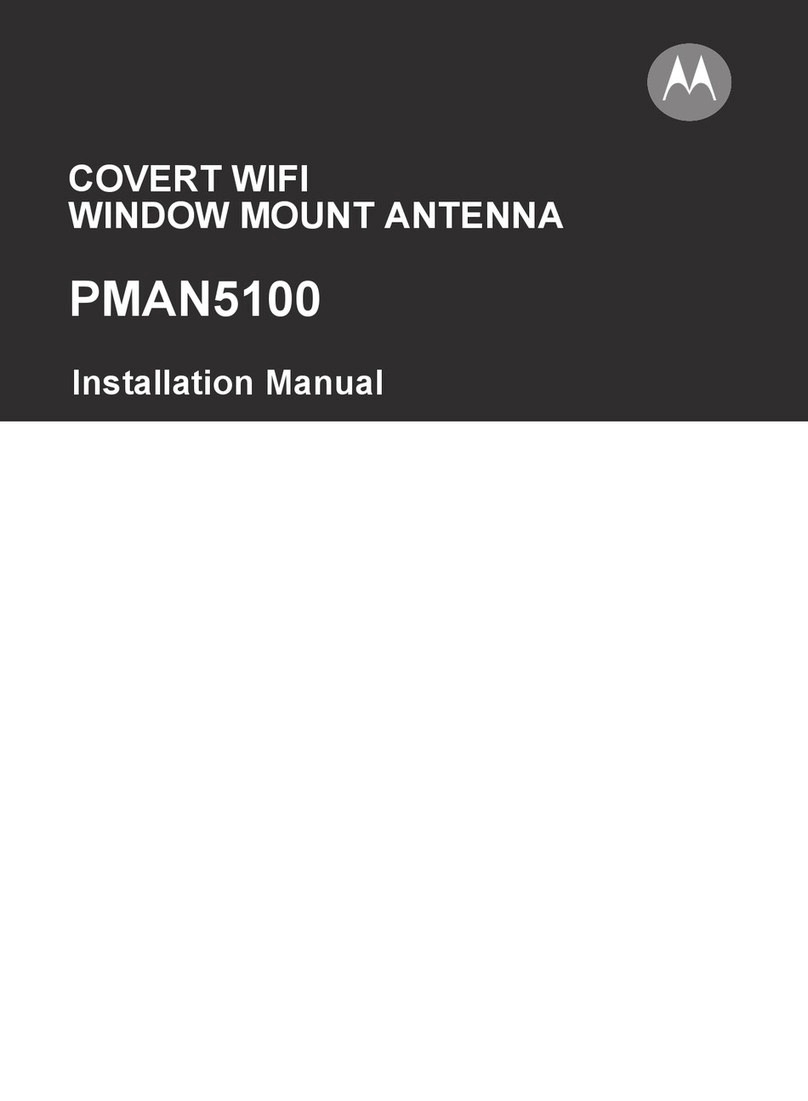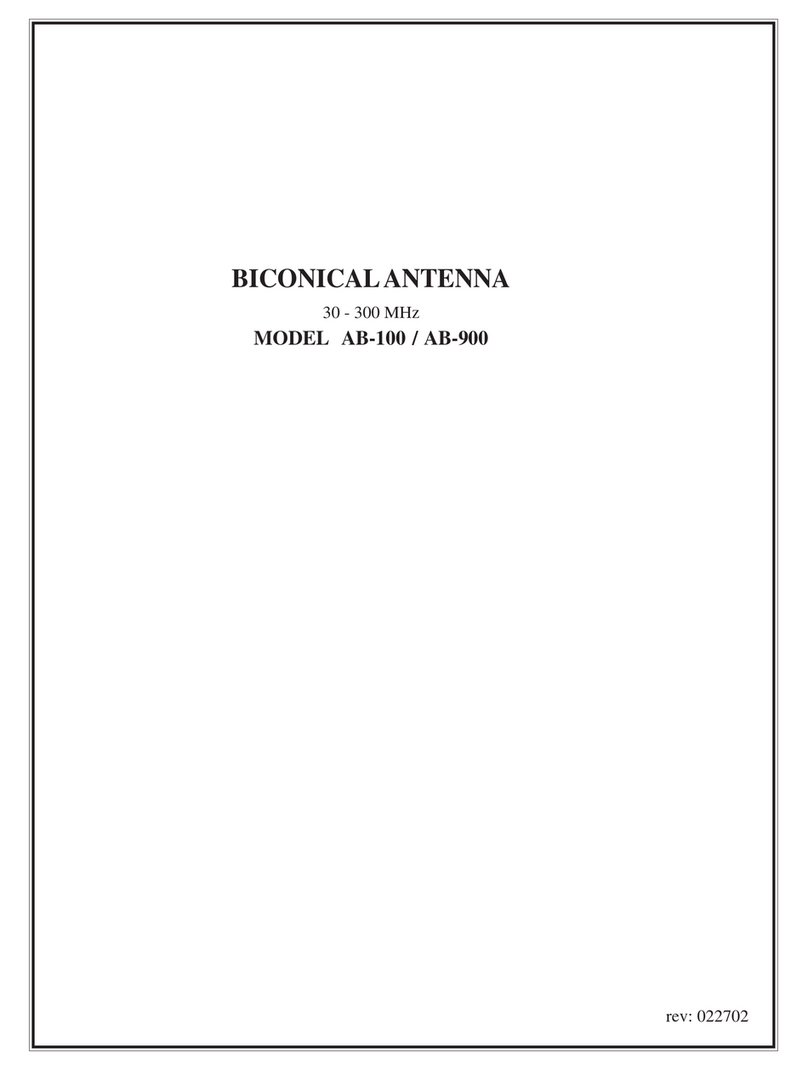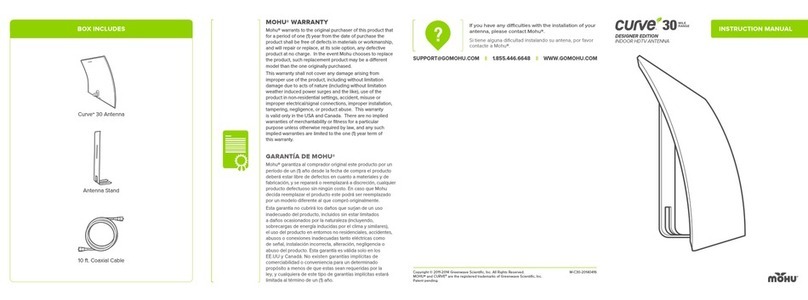Mifare 14443A Installation and operating instructions

READER COMPONENTS
mifare®(14443A)
13.56 MHz RFID Proximity Antennas
Revision 1.0
PUBLIC
November 2002
P
h
i
l
i
ps
Semiconductors

Philips Semiconductors Rev. 1.0 November 2002
13.56 MHz RFID Proximity Antennas mifare®(14443A)
2 PUBLIC
CONTENTS
1INTRODUCTION......................................................................................3
1.1 Purpose and Scope..................................................................................3
1.2 Abbreviations .........................................................................................3
1.3 Reference Documents.............................................................................3
2HOW TO USE THIS DOCUMENT.........................................................4
3THE MIFARE®RF INTERFACE ...........................................................5
3.1 Energy Transmission..............................................................................6
3.2 Data Transmission PCD ÆPICC ..........................................................7
3.3 Data Transmission PICC ÆPCD ..........................................................9
4THE PCD ANTENNA.............................................................................11
4.1 The PCD Antenna size.........................................................................11
4.2 Environmental Influences.....................................................................13
4.3 Antenna Shielding and Compensation ................................................14
5ANTENNA DECISION GUIDE.............................................................20
6ANNEX .....................................................................................................22
6.1 Theory for estimating the optimum PCD antenna radius .....................22
6.2 Parameters and Units............................................................................24
CONTACT INFORMATION................................................................................26

Philips Semiconductors Rev. 1.0 November 2002
13.56 MHz RFID Proximity Antennas mifare®(14443A)
3 PUBLIC
1 INTRODUCTION
1.1 Purpose and Scope
This application note is intended to support RF-related design–in of Micore reader ICs. The aim is to provide
the required understanding of the MIFARE®RF interface (ISO 14443A) to design application specific
antennas and matching circuits to achieve the best performance for a communication with a contactless
MIFARE®card. This paper shall give a background on the system’s RF part and an overview on the used
antenna designs.
1.2 Abbreviations
ASK Amplitude Shift Keying
OOK On-Off Keying
UID Unique IDentifier
RF radio frequency
Micore contactless reader IC family including :
MF RC500
MF RC530
MF RC 531
SL RC400
CL RC632
PCD 13.56MHz Proximity Reader (Proximity Coupling Device according to the ISO14443)
PICC MIFARE®Proximity Card
1.3 Reference Documents
1) “MIFARE®and I Code, Micore Directly Matched Antenna Design”
2) “Data Sheet; SL RC400 I Code Reader IC”
3) “MIFARE®MF RC500; Highly Integrated ISO 14443A Reader IC”
4) “MIFARE®MF RC 530 ISO14443A reader IC”
5) “MIFARE®MF RC531; ISO 14443 Reader IC”
6) “MIFARE®and I Code CL RC632 Multiple protocol contactless reader IC”

Philips Semiconductors Rev. 1.0 November 2002
13.56 MHz RFID Proximity Antennas mifare®(14443A)
4 PUBLIC
2 HOW TO USE THIS DOCUMENT
The chapter 3of this document shows the basic principles of the RF interface as it used with MIFARE®. The
general understanding of this principle helps to do a fast and reliable antenna design based on Micore
reader ICs, but none of the given formulas (especially those in the annex) are necessary to design such an
antenna.
The chapter 4describes some basic facts about the PCD antenna, its optimum size, and how to minimize
environmental influences. The given rules and design recommendations should generally be considered for
a PCD antenna design. This is true for a Micore based antenna design, too.
The chapter 5gives an overview and comparison of the two antenna design principles for Micore antennas.
A help is given to find the best solution based on certain application requirements.
This application note cannot and does not replace any of the relevant datasheets.
“Card” in this document means a contactless smart card according to the ISO14443A (or MIFARE®) or a
contactless tag / label according to the ISO15693 (or I-Code®).
“Micore” includes all contactless reader ICs as the MF RC500, MF RC530, MF RC531, SL RC400 and the
CL RC632. For all of these ICs the antenna matching is the same.
Remarks and Comments are given in italic letters (blue marked).

Philips Semiconductors Rev. 1.0 November 2002
13.56 MHz RFID Proximity Antennas mifare®(14443A)
5 PUBLIC
3 THE MIFARE®RF INTERFACE
The MIFARE®technology describes an ISO 14443-Type A compliant RF interface for a communication
between a PCD and a PICC.
Table 1 gives a short overview on the MIFARE®RF interface. Essentially the MIFARE®RF interface follows
the transformer principle, although both the PCD and PICC antenna of course are resonance circuitries as
antennas usually are. The PICC is passive with no onboard battery. Thus, an energy transmission from the
PCD to the PICC is required in addition to the communication (data transmission) in both directions between
the PCD and the PICC (see Figure 1).
Table 1: Overview MIFARE®RF interface
Energy transmission Transformer principle; MIFARE®card is passive
Operating frequency 13.56 MHz
Communication structure Half duplex, reader talks first
Data rate 105.9 kHz
Data transmission
RWD ÆCard
Card ÆRWD
100 % ASK, Modified Miller Code
Load Modulation, Subcarrier 847.5 kHz,
OOK, Manchester Code
In the following the fundamentals of the MIFARE®RF interface are described starting with the basic energy
transmission. Finally, the data transmission and the used data coding in both directions will be shown.
Figure 1: Mifare Interface Principle

Philips Semiconductors Rev. 1.0 November 2002
13.56 MHz RFID Proximity Antennas mifare®(14443A)
6 PUBLIC
3.1 Energy Transmission
The energy transmission from the PCD to the passive PICC is based on the transformer principle. At PCD
side an antenna coil is required as well as a card coil implemented in the MIFARE®card (PICC). Figure 2
shows the basic principle and the equivalent electronic circuitry.
Figure 2: Transformer Model
The figure’s left part describes the antennas and the energy transmission. The current I in the PCD antenna
coil generates a magnetic flux Φ. Parts of this flux Φflow through the card coil and induce a voltage U in the
card coil itself. This voltage U is rectified and the card IC is activated when the operating voltage is reached.
The induced voltage will vary within the distance between PCD antenna and the PICC. Due to that voltage
variation, the achievable operating distance is limited by the transferred power.
The right part shows the equivalent electrical circuitry, the transformer model.

Philips Semiconductors Rev. 1.0 November 2002
13.56 MHz RFID Proximity Antennas mifare®(14443A)
7 PUBLIC
3.2 Data Transmission PCD ÆPICC
To transfer data between the PCD and the PICC a half-duplex communication structure is used. The PCD
always starts the communication (“reader talks first”). The data transmission from the PCD to the PICC uses
a 100% ASK modulation according to the ISO14443 Type A. Figure 3 shows a typical signal shape.
Figure 3: Data Transmission PCD
Æ
PICC, typical signal shape
Due to the quality factor Q of the antenna the transmitted signal is deformed to the shape shown in Figure 3.
This shape can be used to measure the tuning of the antenna. For details refer to the “MIFARE®and I Code,
Micore Directly Matched Antenna Design”.
As the PICC is passive, the energy for the PICC has to be provided during the communication between PCD
and PICC. Therefore, MIFARE®(ISO14443A) uses an optimised coding to provide a constant level of energy
independently from the data transmitted to the PICC. This is the modified Miller code, which is shown is
shown in Figure 4 in detail.

Philips Semiconductors Rev. 1.0 November 2002
13.56 MHz RFID Proximity Antennas mifare®(14443A)
8 PUBLIC
data bit "0":
data bit "1":
3µs
9.44
µ
s
3µs
9.44
µ
s
previous bit "0"
modulated carrier
previous bit "1"
9.44
µ
s
Figure 4: Data Transmission PCD
Æ
PICC, Miller Coding
The data rate of MIFARE®is 105.9KHz, so the length of a bit frame is 9.44µs. A pulse in the Miller coding
has a length of 3µs.
A logical ‘1’ is expressed with a pulse in the centre of the bit frame.
Two possibilities are given to code a logical ‘0’. This coding depends on the previous bit:
If the previous bit was a ‘0’, the following ‘0’ is expressed with a pulse of 3µs at in the first half of the next bit
frame.
If the previous bit was a ‘1’, the following ‘0’ is expressed without a pulse in the next bit frame.

Philips Semiconductors Rev. 1.0 November 2002
13.56 MHz RFID Proximity Antennas mifare®(14443A)
9 PUBLIC
3.3 Data Transmission PICC ÆPCD
3.3.1 SUBCARRIER LOAD MODULATION PRINCIPLE
The data transmission from the PICC back to the PCD uses the principle of load modulation shown in Figure
5. The PICC is designed as a resonance circuitry and consumes energy generated by the PCD. This energy
consumption has a feedback effect as a voltage drop on PCD side. This effect is used to transfer data from
the PICC back to the PCD by changing the load in the card IC.
Figure 5: Subcarrier Load Modulation Principle
The PCD antenna is tuned to a resonance frequency fR= 13.56 MHz. The time TO expresses the pulse
length of the operating frequency ns
f
TR74
1
0≈= . In fact, this resonance circuit generates voltages at
the PCD antenna several times higher than the supply voltage. Due to the small coupling factor between the
PCD and PICC antenna the PICC’s response is up to 60dB below the voltage generated by the reader. To
detect such a signal, it requires a well designed receiving circuit.
The PICC data transfer back to the PCD uses a data rate of 105.9kbit/s with Manchester coding. At
Manchester Coding each bit is represented by either a raising or a falling edge in the centre of a bit frame.
For the MIFARE®principle this is shown on the right side of Figure 5:
A logical ‘1’ is expressed with a falling edge in the centre of the bit frame.
A logical ‘0’ is expressed with a rising edge in the centre of the bit frame.
This Manchester coded data modulates a sub carrier kHz
f
fR
SUB 5.847
16 == .
Finally, this modulated sub carrier switches the load of the PICC, which results in the load modulation as
shown in the last line of Figure 5, and which is received and decoded again by the PCD.

Philips Semiconductors Rev. 1.0 November 2002
13.56 MHz RFID Proximity Antennas mifare®(14443A)
10 PUBLIC
Figure 6 shows the relation between the time and the frequency domain of the load modulation. Due to the
data rate of s
kBdv
μ
44.9 1
106 ≈≈ the Manchester code generates sidebands at both sides of the sub
carrier frequency:
DataSubcarrier
mSUB kHzkHzf 1065.847 ±=
The modulated sub carrier then generates sidebands at both sides of the carrier frequency:
Data
Subcarrier
Carrier
mR kHzkHzMHzf 1065.84756.13 ±±=
Figure 6: Principle of Data Coding PICC
Æ
PCD, Time and Frequency Domain

Philips Semiconductors Rev. 1.0 November 2002
13.56 MHz RFID Proximity Antennas mifare®(14443A)
11 PUBLIC
4 THE PCD ANTENNA
The achievable operating distance for a Proximity RFID system depends on:
•PCD (and PICC) Antenna size
•Matching of the antenna
•Quality factor of the antenna and matching circuit
•Power of the PCD
•Environmental influences
Assuming that the matching of the antenna is optimised, the Q-Factor, the PICC antenna, and the delivered
power of the PCD are given and fix, only the PCD antenna size and the environmental influences have to be
considered for the antenna design principle. For the details of the Micore antenna design refer to “MIFARE®
and I Code, Micore Directly Matched Antenna Design”.
In the first step the environmental influences are neglected. This can even be done in many practical cases.
The environmental influence and the way, how to avoid it, is shown in chapter 4.2.
4.1 The PCD Antenna size
Based on the transformer principle (as shown in Figure 2) and with the help of the law of the electromagnetic
induction, the law of Biot and Savart the mean flux density in dependence on the operating distance and the
PCD antenna radius can be calculated. Based on the limit of the minimum required field strength as specified
in the ISO14443-2:
m
A
H5.1
min =
the coupling factor can be calculated in dependence on the operating distance and the PCD antenna radius.1
As a rule of thumb the following can be shown (see Figure 7):
2
D
Rx ==
x: maximum operating distance
R: PCD antenna radius
D: PCD antenna diameter
1as shown in the Annex, chapter 6.1

Philips Semiconductors Rev. 1.0 November 2002
13.56 MHz RFID Proximity Antennas mifare®(14443A)
12 PUBLIC
0 10203040
D/cm
kx = 10cm
Figure 7: Coupling factor vs. Antenna diameter
Figure 7 shows the coupling factor k versus antenna diameter D based on the required operating distance of
x = 10cm. The optimum antenna diameter is D = 20cm, which means bigger antennas give no better (but
even less) performance. Although the curve is very flat on its top, it can be seen that an antenna diameter
less than 16cm shows a significant decrease of the coupling factor (and performance). The coupling factor
and performance goes dramatically down at antenna diameter below 12 cm.
Remark:
The above shown relation between antenna size and operating distance is independent on the number of
turns (and the inductance) of the PCD antenna.
The above shown relation is only a first step for a successful antenna design. For a complete design, the
environmental influences as well as antenna size limitations due to application related restrictions have to be
considered.
The coupling coefficient is a limiting factor not only for the energy that is transported to the PICC, but also for
the PICC’s answer that has to be received by the PCD.

Philips Semiconductors Rev. 1.0 November 2002
13.56 MHz RFID Proximity Antennas mifare®(14443A)
13 PUBLIC
4.2 Environmental Influences
4.2.1 METAL ENVIRONMENT
Any alternating magnetic field induces a voltage in metal components positioned nearby the reader antenna.
This induced voltage generates eddy currents in the metal plane. These eddy currents cause loss combined
with a detuning of the antenna and decreasing of the magnetic field. The result of these effects is a reduced
operating distance as well as possible transmission errors.
It is recommended that the distance between antenna and massive metal components is at least as large as
the operating distance (on both sides of the PCD antenna).
To avoid negative influences of a metallic environment a ferrite shielding should be used.
The antenna distance from massive metal should be at least 10cm for full R/W distance, 3cm for
reduced R/W distance, and for close metal ferrite shielding is strictly recommended.
In all cases the tuning of the antenna has to be made with the metal placed in the finally intended
position.
4.2.2 MULTIPLE PCD ANTENNAS
Antennas are resonance circuits with a high quality factor and tuned to the operating frequency. According to
the reciprocity law a good transmitting antenna is also a good receiving antenna and vice versa. This means
that an antenna positioned close to the used reader antenna and tuned to the same frequency dissipates
energy from the field. This causes a detuning of the antenna and a reduced operating distance. If two active
antennas for an MIFARE®application are positioned in a close distance a communication to the card will be
disturbed.
Multiple Proximity PCD antennas should be at least 30 cm away from each other if they are
magnetically shielded and 10 times of the antenna radius if they are not shielded!
4.2.3 TEMPERATURE
The PCD antenna may be detuned as a consequence of temperature drifts of the electrical parameters of the
antenna itself and the matching circuit. This will result in a reduction of the transmitting power available at the
antenna. The consequence will be a reduced operating distance.
Experiments can show that these influences can be neglected when appropriate components with low
temperature coefficient for the matching circuit (SMD capacitors with NP0 dielectric medium) are used.

Philips Semiconductors Rev. 1.0 November 2002
13.56 MHz RFID Proximity Antennas mifare®(14443A)
14 PUBLIC
4.3 Antenna Shielding and Compensation
Three topics shall be discussed.
Electrical Shielding
The electrical shielding absorbs the electrical field generated by the antenna coil as well as the electrical
field of the reader PCB.
Compensation
Compensation should be used to reduce common mode earth currents.
Ferrite Shielding
Ferrite Shielding should be used if metal has to be placed very close to the antenna itself. This metal,
e.g. metal housing of the terminal generates eddy currents. The effect of the eddy currents is a
dramatically reduced operating distance. A ferrite shielding should be used to reduce the generated eddy
currents.
Note: Ferrite shielding will not increase the operating distance above values achievable in non metallic
environment.
4.3.1 ELECTRICAL SHIELDING
4.3.1.1 Directly Matched Antennas
An electrical shielding should be used to reduce the electrical field generated by the antenna coil itself. To
build a shielded antenna on a PCB at least one with 4 layers should be used with the shielding loop on the
top and the bottom layer. These loops must not be closed. The loops provide electrical shielding and
improve the EMC behaviour. The shielding has to be connected in one point to system ground. The coil is
routed in the first inner layer. The centre tap of the coil is done with the marked Via to GND. The connection
of the coil ends to the matching circuit shall be routed close together, to avoid additional inductance.
side view
4 layer PCB
top view
A
B
GND
A
Bground shielding
ground shielding
antenna connector coil wire
Figure 8: Electrical shielding for a directly matched antenna

Philips Semiconductors Rev. 1.0 November 2002
13.56 MHz RFID Proximity Antennas mifare®(14443A)
15 PUBLIC
4.3.1.2 50
Ω
Matched Antennas
An electrical shielding should be used to reduce the electrical field generated by the antenna coil itself. To
build a shielded antenna on a PCB at least one with 4 layers should be used with the shielding loop on the
top and the bottom layer. These loops must not be closed. The loops provide electrical shielding and
improve the EMC behaviour. The shielding has to be connected in one point to system ground.
A
ntenna (4-Layer-PCB)
Tx
TGND
Shield Triax-cable
Figure 9: Electrical shielding for a 50
Ω
matched antenna using a triax cable.
On the top and bottom layers of the PCB a shielding plane is placed directly above the active antenna loop
which is an inside layer of the PCB. These shielding planes must not be closed loops! The shielding should
be connected with a triax cable.

Philips Semiconductors Rev. 1.0 November 2002
13.56 MHz RFID Proximity Antennas mifare®(14443A)
16 PUBLIC
4.3.2 COMPENSATION
TX
TGND
open
Cstray
-I
-V
+V
Cstray +I
Electrical Principle
Coax Cable
Antenna
1 active turn +
1 compensation turn
Implementation
Figure 10: Compensated 50
Ω
antenna
To compensate the stray capacitance of the antenna another turn with an open end is added. Due to the
transformer’s principle the induced voltage in the open loop is inverted. The stray capacitance of the active
and the compensation loop have nearly the same value. The effect will be, that the current across these
capacitance has nearly the same magnitude but opposite direction. By that a compensation of these currents
is done. These currents can reach values in a range of several mA at 13.56 MHz, so compensation is
necessary to avoid problems with ground currents.
4.3.3 FERRITE SHIELDING
The benefit of a ferrite is to shield an antenna against the influence of metal. A metal plane could be part of
the housing of the reader or a ground plane of the reader PCB itself, which has to be connected very near to
the antenna. If metal is placed very near to the antenna the alternating magnetic field generates eddy
currents in the metal. These eddy currents absorb power, and lead to detuning of the antenna due to a
decreased inductance and quality factor. Therefore for operation of an antenna in metallic environment, it is
necessary to shield the antenna with ferrite.
The following examples should give an impression on the influence of ferrite for the distribution of a magnetic
field.
For easy simulation a circular antenna has been used in all case. A circular antenna is rotation symmetrical
to the x-axis. Therefore the simulation can be reduced to a two dimensional mathematical problem. The
simulations shows on the one hand the field distribution of a non disturbed antenna. Common for all
examples: Radius of the RWD antenna 7.5 cm, 1 turn, wire width 1mm copper.

Philips Semiconductors Rev. 1.0 November 2002
13.56 MHz RFID Proximity Antennas mifare®(14443A)
17 PUBLIC
Figure 11 shows the two dimensional field of the circular antenna. The right part shows the field distribution.
The highest field strength is generated in the area of the coil. The left part shows the magnitude of the field
strength H over the distance d. The line of a minimal field strength of HMIN = 1.5 A/m according to ISO 14443
is marked.
0264
d
7.5 cm
minimum field strength
according to ISO 14443
Hmin=1.5 A/m
Field strength
color map
|H| [A/m]
Figure 11: Non disturbed field distribution of a circular antenna
Figure 12 shows the field distribution of the same antenna with a metal plane near to the antenna. Compared
to the disturbed field it is obvious that the magnitude of the field strength has decreased leading to a
decreased operating distance.
0264
5 cm
minimum field strength
according to ISO1443
Hmin=1.5 A/m
Field strength
color map
metal plane
d
|H| [A/m]
Figure 12: Field distribution of a circular antenna with a metal plane

Philips Semiconductors Rev. 1.0 November 2002
13.56 MHz RFID Proximity Antennas mifare®(14443A)
18 PUBLIC
Now, as shown in Figure 13 a ferrite plane (µR=40) is positioned in between the metal plane and the antenna
coil itself. The field strength very near to the ferrite increases, but this increasing of the magnitude is not
combined with an increasing of the operating distance. This is marked once again with the HMIN value
according to ISO 14443.
0264
d
7.5 cm
minimum field strength
according to ISO 14443
Hmin=1.5 A/m
Field strength
color map
metal planeferrite plane
Figure 13: Ferrite shielded field distribution of a circular antenne
These simulations show how the use of ferrite reduces the generated eddy currents in a metal plane. The
ferrite generates an additional field component and the effect for the design of the antenna is a fixed
detuning of the antenna itself.
Figure 14 gives recommendations how to dimension the ferrite to find the optimum dimensions between
ferrite plane and metal plane. To calculate the optimum dimensions of the ferrite plane and the optimum
distance and overlapping is very hard and not recommended. Application specific tests have to be made to
find the best ferrite dimensions.

Philips Semiconductors Rev. 1.0 November 2002
13.56 MHz RFID Proximity Antennas mifare®(14443A)
19 PUBLIC
Optimum distribution:
Balance between stray field
distribution and ferrite
shielding
metalplane
ferriteplane
Eddy
currents
metalplane
ferriteplane
metalplane
ferriteplane
5mm
Reduced stray field
High shielding
Reduced operating distance
Small reduced stray field
Low shielding
Reduced operating distance
Figure 14: Estimation of the optimum ferrite dimensions
Tests have shown that the best performance is achieved when the overlapping of the antenna coil and the
ferrite is in a range of 5 mm. That gives a balance between needed stray field to communicate to the card
and the shielding of the ferrite.
Applying the distance estimation to specific applications, it is recommended to make test to find the best
solution. Once again it has to be mentioned that ferrite does not increase the operating distance compared to
a non-disturbed field.

Philips Semiconductors Rev. 1.0 November 2002
13.56 MHz RFID Proximity Antennas mifare®(14443A)
20 PUBLIC
5 ANTENNA DECISION GUIDE
Micore is a single reader IC family, which is designed to achieve operating distances up to 100mm without
external amplifiers. The design of the remaining passive RF part is straightforward.
Two different concepts are possible to design an antenna and a matching circuit.
•Directly matched antennas can be used to build up small, complete terminals with a minimum
distance between a reader and antenna. Possible applications could be an access control reader in
a small housing or a handheld reader.
•50Ωmatched antennas can be used for an easy solution to achieve long distances between the
reader and the antenna using a coaxial cable. Using a coaxial cable between the reader matching
circuit and the antenna itself, distances up to 10 m between these parts are possible. A high-end
solution to achieve an operating distance up to 100mm as well as a low cost solution for operating
distances lower than 50 mm is available.
At first it has to be decided, which of the possible basic concepts meets the application requirements best.
The design help shown in Figure 15 and the comparison shown in Table 2 shall give a support for this
decision.
Table 2: Comparison of antenna concepts
50 Ωmatched Directly matched
Concept Full range Short range
MF RC 500
EMC-Circuit same circuitry and values
Receiving
circuit same circuit and values
Reader
Impedance
Transformation
using
TX1 and TX2 using
only TX1
---
Cable 50 Ωcoaxial Short wire or directly
connected
Antenna
matching
circuitry
same circuit, but different
values depending on the
antenna size
Same circuit, but different
values depending on the
antenna size
Antenna coil operating distance depends on
the antenna size and
environmental influences
operating distance depends on
the antenna size and
environmental influences
Antenna
Antenna
shielding Shielding depends on the application, e. g. the housing and
environmental influences
Table of contents
Popular Antenna manuals by other brands
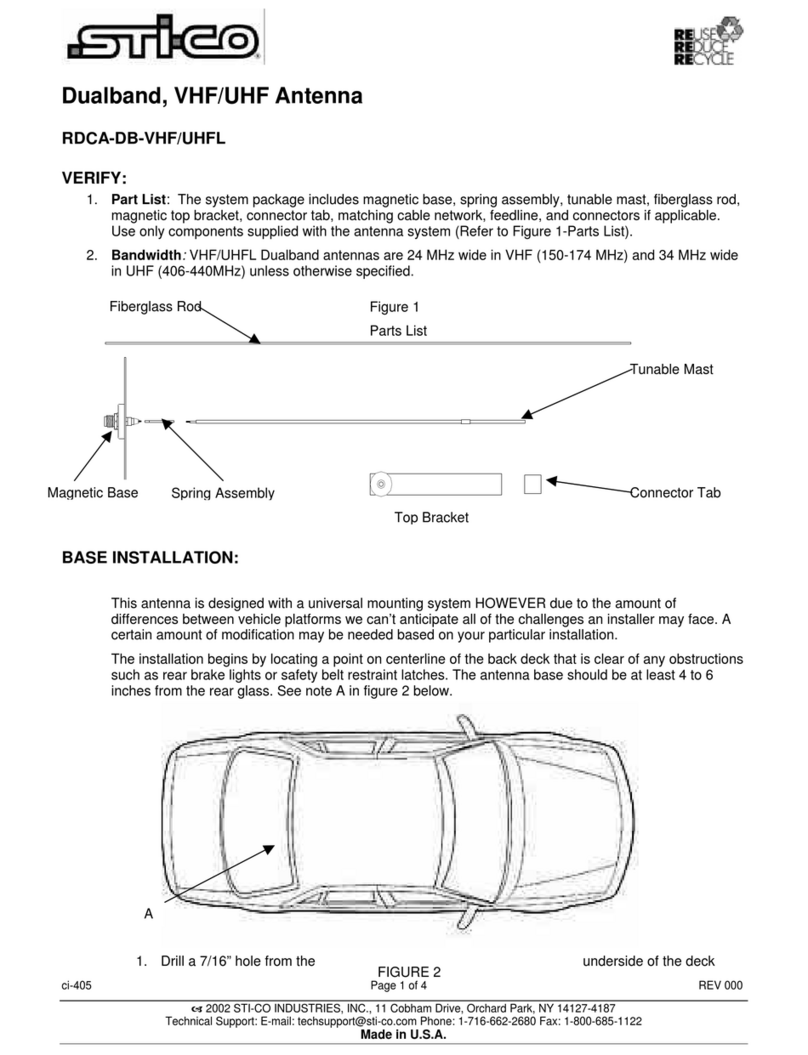
STI-CO
STI-CO Dualband RDCA-DB-VHF/UHFL quick start guide
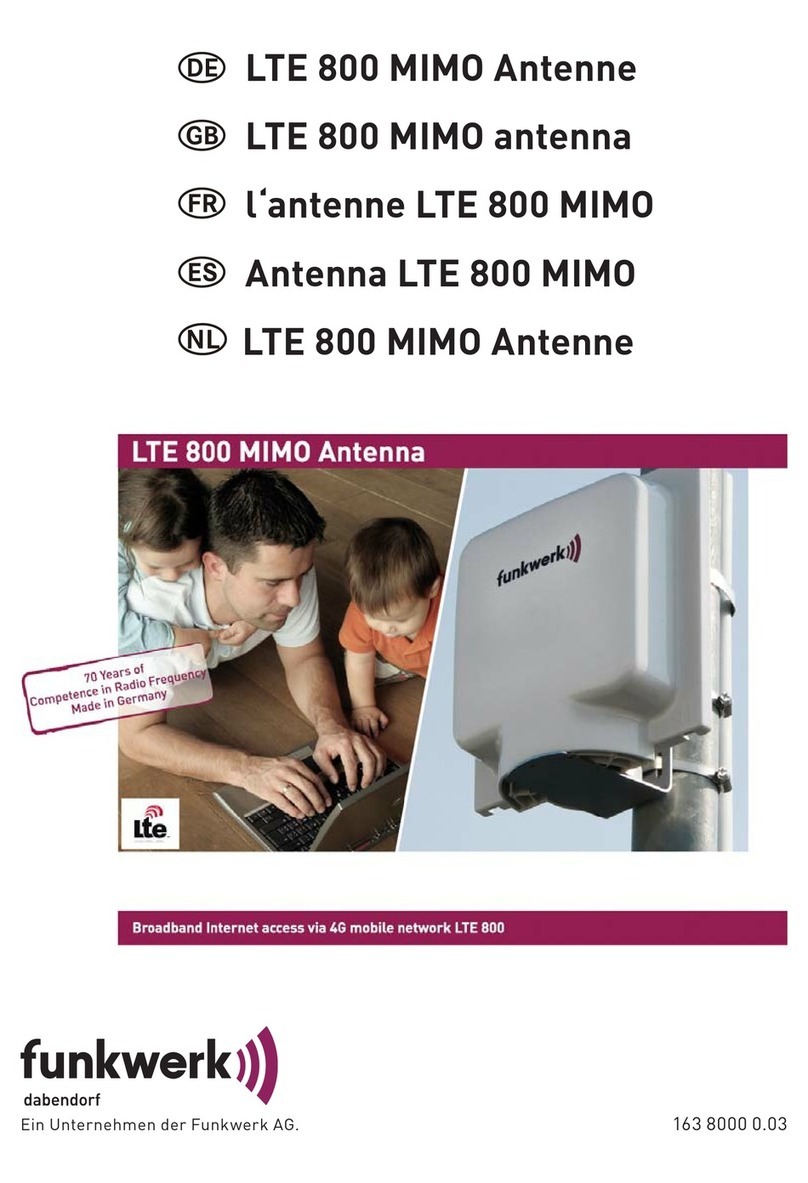
Funkwerk
Funkwerk LTE 800 MIMO installation instructions
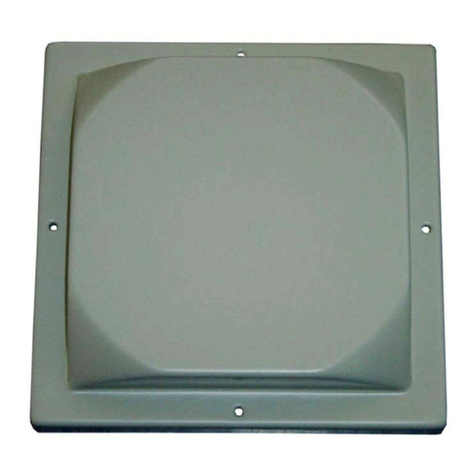
Feig Electronic
Feig Electronic OBID i-scan ID ISC.ANTU250/250 Montage, installation
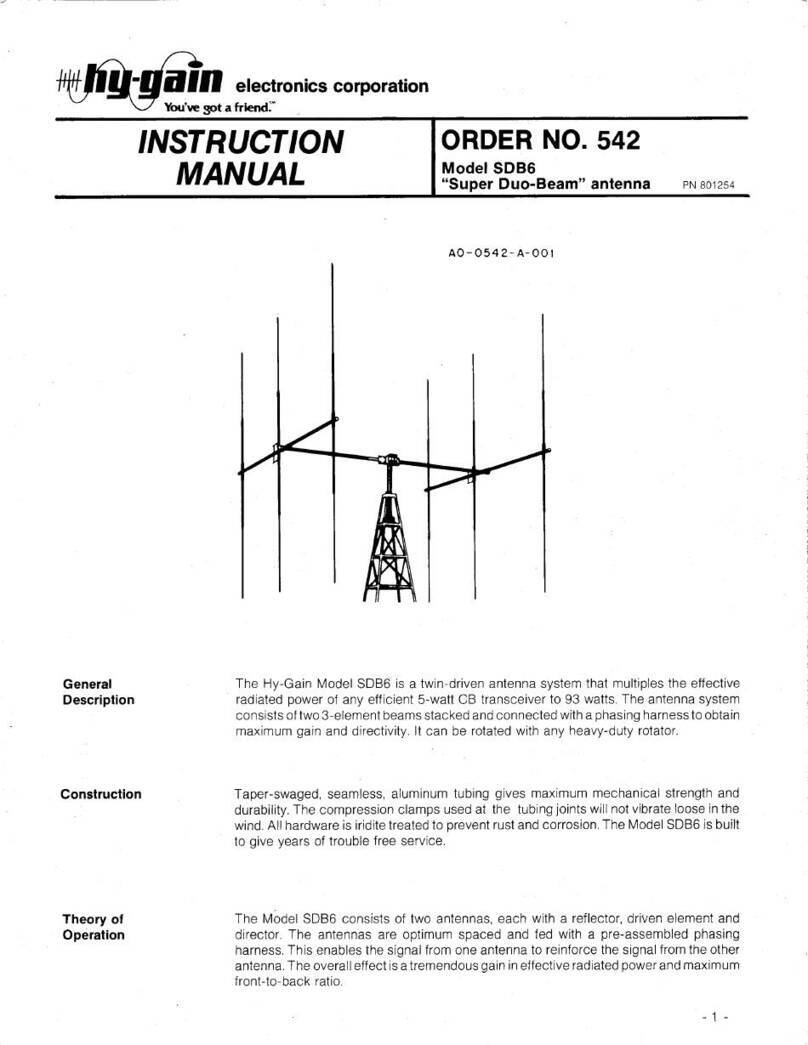
Hy-Gain
Hy-Gain Super Duo-Beam instruction manual
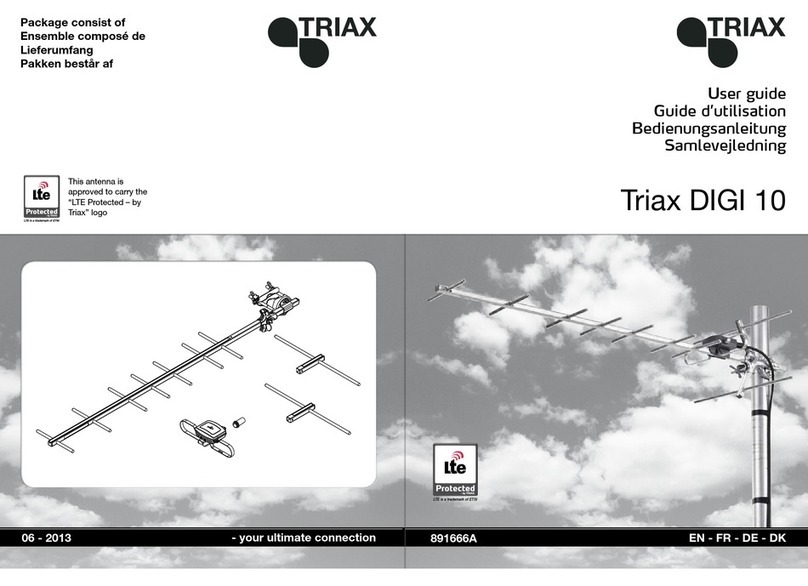
Triax
Triax Digi 10 user guide
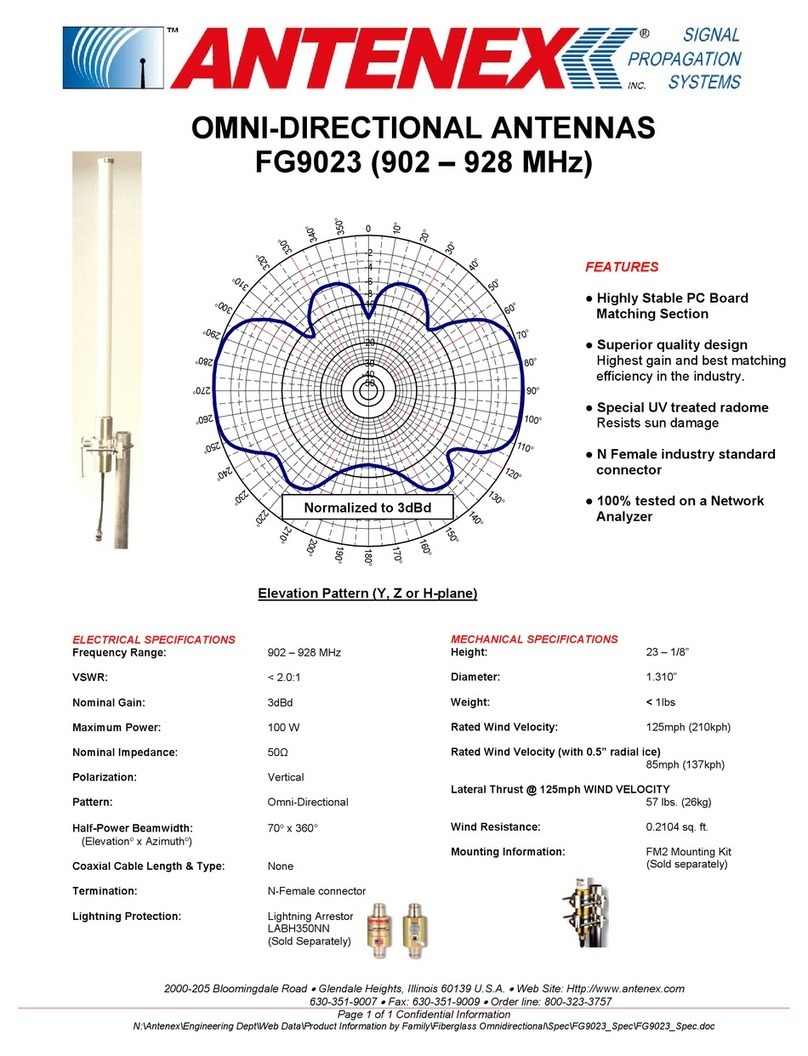
Antenex
Antenex FG9023 Specification sheet






